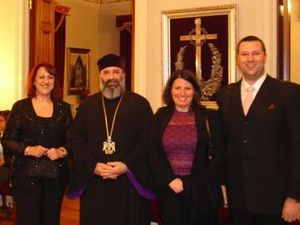 His Beatitude Mesrob II, Armenian Patriarch of Istanbul and all Turkey, flew
His Beatitude Mesrob II, Armenian Patriarch of Istanbul and all Turkey, flew
to south east of Turkey on Sunday July 2, with an entourage that was comprised of the Revd.
Archpriest Muron Ayvazyan; Mr. Vazgen Barin, Deputy Mayor of the Sisli
District; Mrs. Luiz Bakar, the Press Spokesperson of the Patriarchate; press
reporters Mr. and Mrs. Manuel-Sebnem Citak; Mrs. Ayse Nur Yilmazer, the General Manager of Arsan Travel Agency, personally
guided His Beatitude's entourage while in Gaziantep. On 3 July, before noon,
the Patriarch toured the new city of Gaziantep, the Archeological Museum,
the Ethnography Museum, the Old City of Aintab, the ancient Armenian
Cathedral of the Holy Mother-of-God, which had been converted to a state
prison during the first decades of the Republic, and has now become a
mosque.
In the afternoon, the group proceeded, via Yavuzeli in the northeast of
Gaziantep, to the Rumkale (Hromgla) ruins which are at the very spot where
the Merzumen creek joins the Euphrates River. The Patriarch and his company
crossed the Merzumen creek with the help of a primitive boat. The creek's
water level had increased due to the water retained by the Birecik Dam. They
gazed with sorrow at the old village of Kasaba which had been completely
covered by the waters of the dam. The tips of the taller trees and public
buildings like the school were still visible above the water. On the slope
of the opposite hill the new village of Kasaba had emerged. The group
climbed upwards through the East Gate of the Hromgla fortress, and after a
brief search -- and with the help of an old map -- located the site of the
Armenian Church of Saint Nersess. Although the two traditional "khatchkars"
(crosses carved in stones) on the east side were extensively damaged, the
Armenian inscriptions on the upper and lower parts of both khatchkars could
still be read. The north and east walls of the small church had collapsed
inwards, forming a heap of rubble that was 3-4 meters high. The tomb of
Saint Nerses the Graceful was somewhere under the debris. The site may not
be under immediate threat. However, the Birecik Dam will start to hold more
water as of October. Then, the level of water will gradually rise up to the
gates of the fortress. The experts say that, because of its geological
structure, Hromgla will definitely collapse if adequate measures are not
taken. The city walls need to be strengthened with a concrete buttress.
Other places in Hromgla were also visited after a brief prayer asking for
Saint Nersess' intercession, and after parts of a beautiful hymn written by
Saint Nersess were sung.
Visits were made to the Syriac Monastery and the Armenian Church of the Holy
Mother-of-God which had also been used in the past as a mosque. Another
Armenian inscription, hardly recognizable, was spotted inside the western
gate to Hromgla. The group then crossed to the other side of the creek in
the boat. The chief (mukhtar) of the Kasaba Village invited Patriarch
Mesrob and his entourage to his home. The Patriarch met the men of the
village in the garden of the mukhtar's house and listened to their concerns
about the future of the village. The villagers complained that they were
driven out of their homes due to the water of the Birecik dam that kept on
rising and which finally covered the whole village. This is why they were
now living in these small newly built huts, which, compared to their
previous residences, felt very "artificial". The Patriarch was soon
surrounded by the children of the village and he asked them about their
village school, lessons received and their future education.
On Tuesday July 4, Patriarch Mesrob and his company visited the Zeugma ruins
on the Euphrates. Most of the ruins have already been covered with water as
previosly reported by the local and international press. The Patriarch
visited the ruins of a Roman villa approximately 150 meters from the
riverside. French and British archaeologists were working actively to
uncover the ruins.
The group then proceeded to Birecik and from there to the village of
Saylakkaya, formerly called Djibin, the subject of an article in Saveur
magazine some two years ago. The small church of the old Armenian village
had been painted in green and white colours and transformed into a mosque.
The Armenian inscription, hardly legible at all, could be barely seen on the
eastern wall.
Nuri (Mushegh), son of Davut Gungoren and Yeva Martirosyan, invited the
Patriarch to his home. He has been blind since the age of four, and speaks
Armenian fluently with a perfect Istanbul dialect. He said that this was the
first time in 75 years that the Armenian Patriarch of Istanbul was setting
foot in Djibin. The villagers who were very hospitable informed the visitors
that Maryam had died five years ago; she was the last of the 35 Armenian
brides that were left behind in the village following the sad events in
1915. The villagers also stated that the grandmothers of most of the
families in the village were of Armenian origin.
The old man had a beautiful voice and he sang one of the hymns of Saint
Nerses with a most poignant tune. Upon the request of a villager, the
Patriarch visited the cemetery of the village and prayed for the repose of
the soul of his Armenian mother. The group then proceeded from Djibin to
Halfeti and saw that the lower half of the town was now covered by water.
Lunch was taken at the restaurant of the Halfeti gendarmerie, following
which the group returned to Gaziantep.
Patriarch Mesrob and his entourage then paid a courtesy visit to Mr. Muammer
Guler, the Governor of Gaziantep, and Mr. Celal Dogan, the Grand Mayor of
Gaziantep. His Beatitude conveyed his impressions about the visit and his
proposals for developing pilgrimage tours to Aintab and its environs. The
Patriarch pointed out that the Vatican had published stamps in memory of
Saint Nersess of Hromgla and stated that a minimal infrastructure was
necessary in Hromgla in order for the visitors to be able visit his tomb.
The group then visited a mother-of-pearl workshop before heading towards
Gaziantep airport to take the 19:30 flight back to Istanbul.
|


